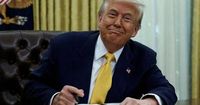On March 20, 2025, U.S. President Donald Trump extended heartfelt Nowruz greetings to those celebrating the Persian New Year, amidst escalating tensions between the United States and Iran over the latter's nuclear ambitions. In a message released by the White House, Trump recognized Nowruz as a significant occasion that symbolizes spring and renewal, noting its importance to the Persian people. He stated, “Nowruz is a joyous occasion for the Persian people, marking the beginning of spring, and the Persian New Year. This long-standing tradition presents a time to reflect on the blessings of the previous year and prepare for the coming spring with a renewed spirit of optimism.”
The U.S. has a substantial Iranian expatriate population, with approximately 620,000 Iranians residing in California alone, as indicated by research from the Harris Poll and UCLA. Moreover, data from the United Nations Population Division in 2019 revealed that the U.S. stands as the most popular destination for Iranians living abroad, showcasing the strong ties between the two populations.
In his message, Trump highlighted the remarkable contributions of Iranians across various fields like math, science, law, technology, and the arts, emphasizing their integral role in American society. However, his statements came during a period characterized by a renewed policy of maximum pressure on Iran, including stricter economic sanctions and diplomatic isolation. This backdrop raises the question: can cultural goodwill coexist with political tension?
Amidst these interactions, Trump dispatched a letter to Iran's Supreme Leader, Ali Khamenei, outlining conditions for potential de-escalation of tensions. In the letter, Trump urged Tehran to dismantle its nuclear program, enforce stringent limits on missile development, and cease its support for regional armed groups. Despite Trump's preference for diplomatic engagement with Iran, he has not shied away from indicating military options should the situation deteriorate.
In stark contrast to Trump's openness to dialogue, Khamenei has firmly prohibited discussions with the U.S. under the prevailing conditions, signaling a complex web of geopolitical challenges and misunderstandings. As the Iranian leader continues to reject negotiations, the hope for a de-escalated relationship seems increasingly fraught, raising concerns about further conflicts.
This tension underscores the conflicting narratives between the two nations, where cultural exchanges like Nowruz celebrations meet the hard realities of international politics. The ability to bridge these divides remains critical, especially considering the historical context of Iranian-American relations.
Looking further into the implications of Trump's Nowruz greetings, some analysts suggest that such cultural acknowledgments might contribute to fostering a deeper understanding between the two countries, even if short-lived. Others argue that these gestures can obscure the underlying hostilities and complicate efforts toward genuine peace.
As of now, the international community watches closely. The juxtaposition of celebratory occasions like Nowruz against a backdrop of political strife poses critical questions about the future of diplomacy between the U.S. and Iran. Will cultural events help mend ties, or will they continue to highlight the growing chasm between the nations? With global attention on the ongoing negotiations and the pressing issues at play, the answers remain uncertain.




